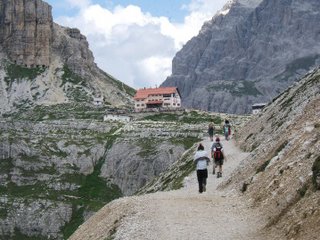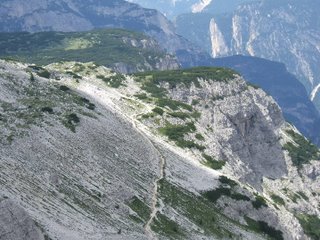Zionist Terrorism & the British
In 1947 Britain was in the unhappy position of holding the Mandate for Palestine and was trying to keep the Jewish and Arab communities apart. The Jews wanted to turn Palestine into the State of Israel and the Arabs wanted to keep their country. A number of Zionist terrorist gangs had been formed and were busy murdering British servicemen and policemen.
A sixteen year old Jewish boy was abducted by a British covert counter-terrorist squad. He was never seen again and it has been claimed that he was tortured and murdered by members of the squad. A hat belonging to the squad's commanding officer, Major Farran, was found at the scene of the kidnapping. Farran was later court-martialed for the murder of the boy.
Cesarini has written a well researched book about the affair. He obviously believes it was an important incident. I am not so sure. Somebody killed a sixteen year old boy and other people in the Palestine administration and UK government behaved dubiously. However, compared to what was to happen in later counter-terrorist operations in Ireland and after 9-11 it was a very minor affair. In Ireland agents of the British government tortured prisoners, operated death squads and planted bombs. There was certainly nothing approaching the horrors of the British operations against the Mau Mau in Kenya.
Most people in the Palestine administration and the British Government behaved well and there were no Abu Ghraibs. Farran was acquitted by his court martial [though in rather dodgy circumstances] and went on to have distinguished career in Canada.
What I found most interesting in the book was not the Farran incident but the scale of Zionist terrorism.
I knew about the King David Hotel bombing. What I did not know was -
- The Jewish terrorist gangs killed a lot of British servicemen and policemen in a long series of incidents. Some of the leaders of these gangs are now commemorated in Israel and two went on to become Prime Ministers of Israel. This is something to remember when the Israeli government prates about Palestinian terrorists.
- The Jewish terrorist gangs conducted a letter bomb campaign in Britain and killed several people, including Major Farran's brother.
- Following some particularly nasty terrorists incidents in Palestine mobs attacked and burnt Jewish businesses in several UK cities.
-It was no surprise to learn that there was a great deal of hysterical and inaccurate reporting by the Daily Mail and other British newspapers.
The British government behaved well during the Jewish terrorist gangs bombing campaign in Britain. Unlike the Blair government they didn't over react and introduce unnecessary and repressive legislation. The police and intelligence agencies were effective with the powers they already had and easily dealt with the terrorists.
The problem of Jewish terrorism went away when Britain pulled out of Palestine. Perhaps the lesson of that is that the problem of Moslem terrorism may well go way when we are no longer in Iraq and Afghanistan.
I thought that Professor Cesarani was rather too indignant about the actvities of Major Farron and some of the other British players in this drama. Despite that the book is well worth reading.
Cesarani, D., 2009. Major Farran's Hat: Murder, Scandal and Britain's War Against Jewish Terrorism, 1945-1948, Heinemann.
West Loch Lomond Cycle Path
The West Loch Lomond Cycle Path runs from Tarbet near the top end of Loch Lomond to Balloch at the bottom of the loch. The path is about 28 kilometers long, and runs along the west bank of Loch Lomond, between the loch banks and the busy A82 road. It is best ridden from north to south, unless you prefer doing more cycling uphill than downhill.
If you would like to do the ride you can start by taking the Oban/Mallaig train to Arrochar & Tarbet Station from Glasgow's Queen Street Station. The train takes about 80 minutes, and goes up the shores of Gare Loch; passing the submarine base and the nuclear weapons store dug into the hillside. After you leave Tarbet Station you should turn left and ride down the hill to the tourist information office by the loch. The path starts a few yards away on the A82. The first few miles of the ride are on the pavement of the A82. For the remainder of the ride the path runs either alongside the road, or between the road and the loch. The path is poorly signposted. It has signs where they are not needed, and none where they are.

It is a pleasant enough ride, but is dominated by the noisy traffic on the A82. Too much of the path runs directly alongside the A82, and the rest is not very far away. The golf courses and commercial developments along the side of the loch [how did they happen in a national park] further push the path away from the water.

When you get to the end of the path you can either catch a train from Balloch Station [near to the bridge], or you can extend your ride along the Loch Lomond to Glasgow Cycleway. There are railway stations at each end of the West Loch Lomond Cycle Path, but none along its length. However, there are lots alongside the Loch Lomond to Glasgow Cycleway, and you can catch a train when you have had enough.
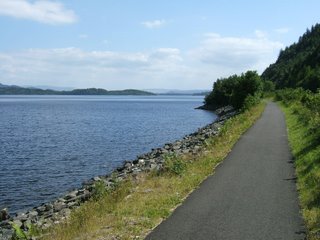
MAP
If you would like to do the ride you can start by taking the Oban/Mallaig train to Arrochar & Tarbet Station from Glasgow's Queen Street Station. The train takes about 80 minutes, and goes up the shores of Gare Loch; passing the submarine base and the nuclear weapons store dug into the hillside. After you leave Tarbet Station you should turn left and ride down the hill to the tourist information office by the loch. The path starts a few yards away on the A82. The first few miles of the ride are on the pavement of the A82. For the remainder of the ride the path runs either alongside the road, or between the road and the loch. The path is poorly signposted. It has signs where they are not needed, and none where they are.

It is a pleasant enough ride, but is dominated by the noisy traffic on the A82. Too much of the path runs directly alongside the A82, and the rest is not very far away. The golf courses and commercial developments along the side of the loch [how did they happen in a national park] further push the path away from the water.

When you get to the end of the path you can either catch a train from Balloch Station [near to the bridge], or you can extend your ride along the Loch Lomond to Glasgow Cycleway. There are railway stations at each end of the West Loch Lomond Cycle Path, but none along its length. However, there are lots alongside the Loch Lomond to Glasgow Cycleway, and you can catch a train when you have had enough.

MAP
Culross
Culross is a delightful small town on the north bank of the Firth of Forth, just west of Edinburgh. It has many unique historical buildings and is well worth visiting.
It didn't use to be such an attractive place. During the 16th and 17th centuries, the town was a centre for coal mining. The yellow building below [Culross Palace] was built for Sir George Bruce of Carnock who was an innovator in coal mining techniques. In 1575 his mine into the Upper Hirst coal seam was the first in the world to extend out under water. Then he built a 240 foot vertical shaft up from the undersea mine to a platform out in the Firth from where the coal could be loaded into ships.
Sir George Bruce invited James VI to visit the undersea mine. James went down the shaft and then up the vertical shaft to the coal loading platform.
'Alarmed to find himself surrounded by water at the top of the shaft,
James accused Sir George of an attempt on his life and declared that the
whole affair was an act of treason. It was only when George Bruce pointed out a rowing boat and explained that one could either use that or return by the tunnel from whence they came that James relaxed again.'
Culross exported coal and salt and the red tiles that roof many buildings are thought to have been brought back as ballast from Holland.
Many of the streets are cobbled.
Admiral Thomas Cochrane, whose life and exploits served as a source of inspiration for the naval adventures of C. S. Forester's Horatio Hornblower and Patrick O'Brian's Jack Aubrey, spent much of his early life in Culross. His family had an estate nearby.
On a hill above the town there are the remains of a 13th century Cistercian abbey that visitors can wander around. The abbey is derelict but its church is still in use. It contains a 1642 tomb with alabaster images of Sir George Bruce, Laird of Carnock, his wife, and eight children.
The abbey graveyard holds the grave of a Victoria Cross holder from the Siege of Lucknow [Indian Mutiny].
It didn't use to be such an attractive place. During the 16th and 17th centuries, the town was a centre for coal mining. The yellow building below [Culross Palace] was built for Sir George Bruce of Carnock who was an innovator in coal mining techniques. In 1575 his mine into the Upper Hirst coal seam was the first in the world to extend out under water. Then he built a 240 foot vertical shaft up from the undersea mine to a platform out in the Firth from where the coal could be loaded into ships.
 |
| Culross Palace |
Culross exported coal and salt and the red tiles that roof many buildings are thought to have been brought back as ballast from Holland.
Many of the streets are cobbled.
 |
| Snuff Cottage |
 |
| The recycling bins need to go |
The abbey graveyard holds the grave of a Victoria Cross holder from the Siege of Lucknow [Indian Mutiny].
Clarence Henry Willcock and identity cards
Compulsory identity cards had been re-introduced into the UK during World War II. After the War the Labour government decided, under prompting from the police and secret police, decided they would quite like to continue the scheme.
In December 1950, Harry Willcock, 54 year old dry-cleaning manager was stopped while driving in London by a police constable who demanded that he present his identity card at a police station within 48 hours.
Wilcock refused and was prosecuted under the National Registration Act 1939, convicted and fined 10 shillings. During his trial he argued that identity cards had no place in peace time.
In his subsequent appeal the Lord Chief Justice of England and Wales upheld the judgement of the lower court, though in summing up, the Lord Chief Justice showed sympathy for the defence;
"This Act was passed for security purposes, and not for the purposes for which, apparently, it is now sought to be used. To use Acts of Parliament, passed for particular purposes during war, in times when the war is past, except that technically a state of war exists, tends to turn law-abiding subjects into lawbreakers, which is a most undesirable state of affairs.
Further, in this country we have always prided ourselves on the good feeling that exists between the police and the public and such action tends to make the people resentful of the acts of the police and inclines them to obstruct the police instead of to assist them."
Mr. Wilcock then started a campaign against ID cards. When a Conservative government came to power it scrapped ID cards, against the wishes of the police and the security services.
Link
In December 1950, Harry Willcock, 54 year old dry-cleaning manager was stopped while driving in London by a police constable who demanded that he present his identity card at a police station within 48 hours.
Wilcock refused and was prosecuted under the National Registration Act 1939, convicted and fined 10 shillings. During his trial he argued that identity cards had no place in peace time.
In his subsequent appeal the Lord Chief Justice of England and Wales upheld the judgement of the lower court, though in summing up, the Lord Chief Justice showed sympathy for the defence;
"This Act was passed for security purposes, and not for the purposes for which, apparently, it is now sought to be used. To use Acts of Parliament, passed for particular purposes during war, in times when the war is past, except that technically a state of war exists, tends to turn law-abiding subjects into lawbreakers, which is a most undesirable state of affairs.
Further, in this country we have always prided ourselves on the good feeling that exists between the police and the public and such action tends to make the people resentful of the acts of the police and inclines them to obstruct the police instead of to assist them."
Mr. Wilcock then started a campaign against ID cards. When a Conservative government came to power it scrapped ID cards, against the wishes of the police and the security services.
Link
Up to the Turquoise Lake [Rif. Vandelli Traverse]

The proper name for the Turquoise lake is the Lago di Sorapiss. It is in the Italian Dolomites, to the east of Cortina.
The first part of the path starts at the Passo Tre Croci and was first established as a mule track in World War I. You pass a couple of overgrown forts, and then climb up through woods, and on a path that winds around the side of the mountain.
Cables have been set up where there is any exposure, but they are not really necessary. At one point there are a series of ladders to lift the path to a higher level. Most of the ladders in the Dolomites are pretty basic. Mainly of metal, but occasionally of wood. Often there are just stemples [rungs driven into a rock face]. These ladders are luxurious, with handrails and broad metal steps.

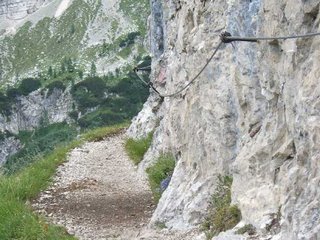

After about two hours you reach Refuge Vandelli where you can get food, drink and accommodation.
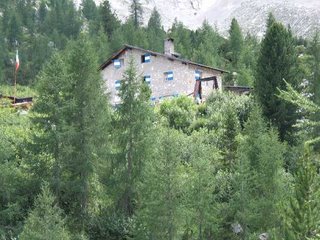

The lake is just a few minutes further along from the Refuge. The colour comes from suspended powdered debris from shrinking glaciers on the north wall of Punta Sorapiss.
The path continues on the other side of the lake, rising steeply and with some exposed stretches. There are supposed to be herdes of chamois in the trees above the lake.
Map of walks and via ferrata
See also
Strada delle Gallerie
Via Ferrata Lagazuoi Tunnels
Monte Piana
Harvington Hall - a moated manor house
Harvington Hall is a 16th century moated manor house located south-east of Kidderminster in England. It was built in the 1580s, at one point was left derelict, and is now owned by the Roman Catholic Church.
It is open to the public. The visitors fee is £5. You can go around on your own or join a tour led by a volunteer. It is well worth joining a tour. Mine was very interesting and informative.
As you can see from the photograph it is a very attractive building with its red brick and sandstone.
Harvington Hall is known for having more priest holes than any house in England. A priest hole is a hiding places for priests built into many of the principal Catholic houses of England during the period when Catholics were persecuted by law in England. This persecution started early in the reign of Queen Elizabeth I in 1558.
Nicholas Owen, who was the leading builder of priest holes, must have spent a long time at Harvington Hall.
Whoever built them displayed a sound knowledge of practical psychology. For example, this one was underneath a corridor. If the trapdoor had been put in a room there would have been the danger that someone sitting in the room might might notice some anomaly and investigated, but nobody lingers in a corridor.
This one was under some stairs. If somebody lifted the stairs they would find a jewellry store. Greed might then lead them to steal the jewellery and forget to investigate further and find the priest hole beyond.
However, it tilts up to reveal a priest hole. This hole was so well hidden that it was only discovered in the 20th century by some children who were playing.
My favourite was this one. The priest hole is in the ceiling of a room and to get to it you have to climb up this chimney.
It would have been interesting to see more on the history of the house and how it was restored. There could also have been more on Elizabeth's persecution of the Catholics that created the need for the priest holes.
Harvington Hall is well worth a visit.
It is open to the public. The visitors fee is £5. You can go around on your own or join a tour led by a volunteer. It is well worth joining a tour. Mine was very interesting and informative.
As you can see from the photograph it is a very attractive building with its red brick and sandstone.
Nicholas Owen, who was the leading builder of priest holes, must have spent a long time at Harvington Hall.
Whoever built them displayed a sound knowledge of practical psychology. For example, this one was underneath a corridor. If the trapdoor had been put in a room there would have been the danger that someone sitting in the room might might notice some anomaly and investigated, but nobody lingers in a corridor.
The piece of wood on the left just looks like a supporting timber.
However, it tilts up to reveal a priest hole. This hole was so well hidden that it was only discovered in the 20th century by some children who were playing.
My favourite was this one. The priest hole is in the ceiling of a room and to get to it you have to climb up this chimney.
It would have been interesting to see more on the history of the house and how it was restored. There could also have been more on Elizabeth's persecution of the Catholics that created the need for the priest holes.
Harvington Hall is well worth a visit.
Other moated manor houses
See my posts on Ightham Mote and Baddesley Clinton [Baddesley Clinton is about 20 miles to the east of Harvington Hall. The house is under the care of the National Trust.]
How much to bail out Theresa May?
The UK's Home Secretary has finally got Abu Qatada on a plane to Jordan.
Jordan has agreed to give him their version of a fair trial.
The Abu Qatada farce appears to be over but I would like to know how much it cost to get the Jordanians to take him.
Abu Qatada was no danger to us. He was in jail. However, as National Bogeyman, he was a danger to Theresa May and her ambition to be Prime Minister. She had to look tough and get him out of the country.
May is basking in the praises of the press and dimwit MPs but the question nobody seems to be asking is what we had to give Jordan to get them to take the Bogeyman. I suspect it was a lot. They would know they had May over a barrel and could ask whatever they liked.
Jordan has agreed to give him their version of a fair trial.
The Abu Qatada farce appears to be over but I would like to know how much it cost to get the Jordanians to take him.
Abu Qatada was no danger to us. He was in jail. However, as National Bogeyman, he was a danger to Theresa May and her ambition to be Prime Minister. She had to look tough and get him out of the country.
May is basking in the praises of the press and dimwit MPs but the question nobody seems to be asking is what we had to give Jordan to get them to take the Bogeyman. I suspect it was a lot. They would know they had May over a barrel and could ask whatever they liked.
UK elects Len McCluskey as new National Bogeyman
Following the deportation of Abu Qatada, the UK's long serving National Bogeyman, tabloid newspapers announced that Mr. Len McCluskey, the General Secretary of the Unite trade union, had been elected as his successor.
A baying pack of journalists and BBC reporters has already started off in pursuit of Mr. McCluskey.
The government has announced that a Two Minute Hate would be held in Parliament to allow all party leaders and MPs to vilify the new Bogeyman.
Mr. McCluskey said he was enormously excited and looking forward to his new role.
[Note to foreign readers - The post of UK National Bogeyman was created by the tabloid press to frighten children, politicians and Daily Mail readers]
 |
| Mr McClusky |
The government has announced that a Two Minute Hate would be held in Parliament to allow all party leaders and MPs to vilify the new Bogeyman.
Mr. McCluskey said he was enormously excited and looking forward to his new role.
[Note to foreign readers - The post of UK National Bogeyman was created by the tabloid press to frighten children, politicians and Daily Mail readers]
San Leo Castle
Photographs of the village, castle and museum.

San Leo Castle is a the Marche region of Italy. Next to the castle there is a pleasant little village with a large square and a few shops and cafes.

 The castle is higher up the hill. For much of its life it has been used as a prison. Popes used to stick nuisances in the castle. They would have had nice views and I would imagine there were worse places to while away a few decades.
The castle is higher up the hill. For much of its life it has been used as a prison. Popes used to stick nuisances in the castle. They would have had nice views and I would imagine there were worse places to while away a few decades.
The castle itself is undistinguished and clearly felt it needed something a little extra to spice itself up. What better than a torture museum to attract the punters? The ghoulish are always with us and go on holidays like everyone else.


As you can see from the photographs there is a small but quite sound collection of tormenting equipment.

The idea of the barrel was apparently to confine somebody in their very own porta-potty.

I am always amazed how much effort people used to put into devising ever more elaborate equipment to discomfort their enemies. Just look at that chair.
 You can just hear the designer chuckling fiendishly.
You can just hear the designer chuckling fiendishly.
 This looks like a early version of a thrill ride.
This looks like a early version of a thrill ride.
 The people who thought up all this equipment were just trying too hard. The Yanks have demonstrated that if you want to torture someone all you need is a plank and a jug of water.
The people who thought up all this equipment were just trying too hard. The Yanks have demonstrated that if you want to torture someone all you need is a plank and a jug of water.

San Leo Castle is a the Marche region of Italy. Next to the castle there is a pleasant little village with a large square and a few shops and cafes.

 The castle is higher up the hill. For much of its life it has been used as a prison. Popes used to stick nuisances in the castle. They would have had nice views and I would imagine there were worse places to while away a few decades.
The castle is higher up the hill. For much of its life it has been used as a prison. Popes used to stick nuisances in the castle. They would have had nice views and I would imagine there were worse places to while away a few decades.The castle itself is undistinguished and clearly felt it needed something a little extra to spice itself up. What better than a torture museum to attract the punters? The ghoulish are always with us and go on holidays like everyone else.


As you can see from the photographs there is a small but quite sound collection of tormenting equipment.

The idea of the barrel was apparently to confine somebody in their very own porta-potty.

I am always amazed how much effort people used to put into devising ever more elaborate equipment to discomfort their enemies. Just look at that chair.
 You can just hear the designer chuckling fiendishly.
You can just hear the designer chuckling fiendishly. This looks like a early version of a thrill ride.
This looks like a early version of a thrill ride. The people who thought up all this equipment were just trying too hard. The Yanks have demonstrated that if you want to torture someone all you need is a plank and a jug of water.
The people who thought up all this equipment were just trying too hard. The Yanks have demonstrated that if you want to torture someone all you need is a plank and a jug of water.
Subscribe to:
Comments (Atom)







